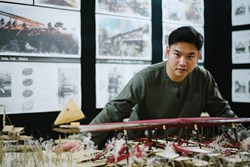Steven Webster from Te Wānanga Aronui o Tāmaki Makau Rau—Auckland University Of Technology, School of Future Environments—Huri te Ao is a finalist for his project 'in(ter)dependence'.
Project description
in(ter)dependence is a design-based research project that explores how architecture and architectural systems can support agricultural self-sufficiency in urban fabrics. The project aims to develop an agroecological architecture that is sensitive to Indigenous knowledge and practices, that builds local food systems, economies and more-than-human communities. This project seeks to pivot from dependence on the current harmful industrial food system, instead empowering a distributed, context-responsive
and ecological approach.
Situated in a future beyond our present day, this project intervenes in a world suffering from the impacts of anthropogenic climate change, extensive biodiversity loss and widespread social inequities. Intervening at the precipice of societal change, in(ter)dependence catalyses the shift from the Anthropocene to the Ecocene, through interventions within the urban fabric. This project ultimately seeks to disestablish dependence on our broken commercialised food system. Instead, empowering a distributed, context-responsive approach through the establishment of interventions – architectural and otherwise – that support flaxroots agroecological initiatives and later the establishment of a central node in this web, the Memorial to the Sixth Mass Extinction. The distributed approach not only increases accessibility but also empowers human communities to connect with food production and value the intrinsic interdependencies shared with more-than-humans. Located within Tāmaki Makaurau the project focuses its intervention on the suburb of Māngere. Interrogation of the wider site vernacular distilled two core typologies: the mound, or
maunga, and the glasshouse. These typologies are investigated to reveal their distinct and definitive characteristics, resulting in the programmes of their architecturalisation. For the mound aspect, these programme(s) stem from the notions of the underground, germination, solemness, and latent potential, these programmatically manifest as a memorial space for species lost during the Anthropocene. For the glasshouse, the programme embodies notions of efficient productivity and a lively, lightweight structure full of light that enables the supporting infrastructures of the Ecocene.






